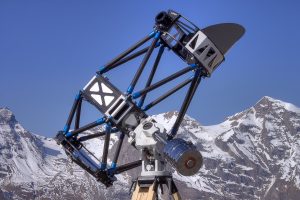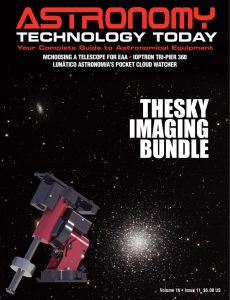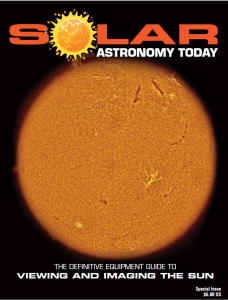Vātes-Astrographs are an intial offering from NAURIS, a new telescope company based in Germany. According to NAURIS, the idea behind the telescopes was to create a concept that incorporated designs meant to compliment the rapid development and performance that cameras equipped with CMOS sensors have undergone in recent years. The Vātes-Astrographs’ design provides a fast and lightweight Newtonian-Astrograph that offers the company’s take on new characteristics on the optical system and the supporting mechanics.
Vātes-Astrographs were also designed to offer the ability to facilitate transport. The telescopes are available in two versions which differ in transport dimensions, weights and assembly/disassembly effort.
Standard-Version
The Standard-Version typically requires about 15 minutes of assembly time. It offers transportability with a lower pricing structure than the company’s more assembly-friendly Travel-Version. It is suitable for observatory installations while still offering ease of setup.
As the NAURIS team notes, “The Standard-Version design corresponds to the classic-design (with some improvements) as it is known from other designs. Primary-mirror cell, center section, and UTA are transported separately, as well as the 16 trusses, which are pairwise connected to 8 pairs. Up to D400mm, the assembly can be done by one person; above that size, it is recommended to assemble with two persons. Each truss-pair is first attached to the center section. Then the center section is placed on the primary-mirror cell and connected to it with eight thumbscrews. In the next step, the center section plus primary-mirror cell should be connected to the mount via the dovetail. With the mechanics set approximately vertically, the UTA is placed on top and fastened via eight additional knurled screws.”
Travel-Version
Astronomers who want to enjoy a large telescope and travel to dark skies will appreciate the advantages of the second Vātes variant, the Travel-Version. The concept behind the Travel-Version is to allow fast uncomplicated transport and setup. The instrument is transported in either three or four main components, with the sixteen trusses remaining an integral part of these components. In addition to a set-up time of only 3-5 minutes, the basic alignment is almost perfectly preserved each time the instrument is set up again. This shortens the adjustment procedure, which can start directly with fine-tuning.
In addition to the well-thought-out connection of the individual components, the low weight of all Vātes-astrographs also supports transportability. You can learn more about the features and specifications of the the Vātes-Astrographs here.

 And to make it easier for you to get the most extensive news, articles and reviews that are only available in the magazine pages of Astronomy Technology Today, we are offering a 1-year magazine subscription for only $6! Or, for an even better deal, we are offering 2 years for only $9. Click here to get these deals which only will be available for a very limited time. You can also check out a free sample issue here.
And to make it easier for you to get the most extensive news, articles and reviews that are only available in the magazine pages of Astronomy Technology Today, we are offering a 1-year magazine subscription for only $6! Or, for an even better deal, we are offering 2 years for only $9. Click here to get these deals which only will be available for a very limited time. You can also check out a free sample issue here.
The sun is more active than it has been in years! If you’d like to learn more the technology behind solar observing, solar imaging and more, you can check out our free publication, “The Definitive Guide to Viewing and Imaging the Sun”. You don’t have to sign up or provide any information, simply click here and enjoy reading!

